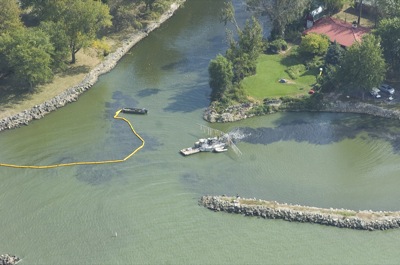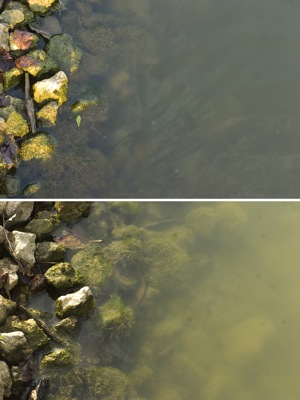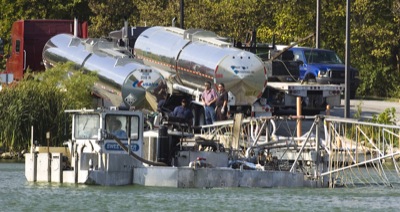Saturday, September 25th, 2010
Alum application in lake complete
Not all sites tested due to shallow water
By Nancy Allen

Photo by Mark Pummell/The Daily Standard
This aerial view shows a 30-foot-long barge distributing alum in Grand Lake at Otterbein Retirement Community on Thursday afternoon. Alum (the light area) will cause phosphorous in the water to bind and drop to the lake's bottom, making it unavailable to blue-green algae as a food source. The dark area in the picture shows water being churned up by the barge.
GRAND LAKE - Alum application was scrapped at two of five sites on Grand Lake this week because the water was too shallow, but treated areas produced positive results, officials say.
The treatment is part of a 60-day pilot study being conducted by the state of Ohio to determine if alum (aluminum sulfate) can help rid Grand Lake of toxic blue-green algae. Alum binds phosphorous and makes it sink to the lake's bottom, taking away the algae's food source.
"Yesterday at Harmon's Landing in some areas you could see down as far as 41/2 feet," said Scott Fletcher of the Ohio Department of Natural Resources. "You could actually see fish."
Sites receiving the alum include 13 acres at Harmon's Landing, a 5.25-acre channel at Otterbein Retirement Community and 8.75-acres at the West Bank boat ramp. Planned test areas not treated include a 7.55-acre channel at Otterbein and 10.18 acres at the Mercer County 4-H camp. The lake is four inches shallower than it was a month ago and the 30-foot-long barge used to apply the alum could not enter the channels, Fletcher said.
John Holz, with Tetra Tech, the consulting firm hired to design the alum study and analyze the results, said the hope is that phosphorous levels will be reduced enough to decrease the toxic blue-green algae to a point that good, diatom algae can become dominant.
Blue-green algae has higher nutrient requirements than diatom algae, he noted.
"So if we keep phosphorous levels lower, the blue-green algae will not get to nuisance levels, meaning frequent and intense blooms, and the good algae should dominate," he said.
The Harmon's Landing application began at 8:30 a.m. Thursday but was suspended for about 90 minutes after dissolved oxygen levels dropped and a minimal amount of shad died. The application resumed and was completed with no further low oxygen levels, Fletcher said.
The reaction was not caused by the alum, rather from some of the algae dying quickly as it was carried to the bottom with the phosphorous, Fletcher said. When algae decomposes it takes up oxygen, which can drop dissolved oxygen levels.
Dissolved oxygen levels at the Harmons' site were at safe ranges this morning. The area had low levels before the application began, he noted, due to the overabundance of algae.
In fact, dissolved oxygen levels were better Friday at the Harmon's site than they were before the alum was applied on Thursday, said Russ Gibson of the Ohio EPA.
About 5 p.m. Friday Fletcher reported the appearance in the water clarity at the Otterbein channel was "dramatic" just two hours following treatment.
"There's shad swimming up in the shallows at the shore and you can visually see the floc layer of algae and alum. It looks like a whitish-greenish fluff." Fletcher said. "We're very optimistic about the results we anticipate seeing."
The Ohio EPA will sample the water for phosphorous, pH, dissolved oxygen and water clarity readings during the 60-day test, Fletcher said. Samples also will be taken from an outside control site to compare treated and untreated lake water. Curtains installed around each of the sites will be removed in November.
If the study is a success, the entire lake could be treated in the spring at an estimated cost of $10 million, Fletcher said. The pilot project is being funded through a $250,000 Ohio EPA grant. Officials have said they "will leave no stone unturned" to find the money needed if the test is successful.
Fletcher noted a whole-lake treatment would be used as a short-term solution to reduce internal loading - phosphorous already in the lake.
During the temporary fix, the state plans to make changes in land management practices in the 98,000-acre Grand Lake watershed to reduce external loading - the amount of phosphorous running off land and into the lake. Most of the phosphorous comes from farmland, which comprises more than 80 percent of the watershed.
A second short-term solution being tested involves adding silica (sand) to the lake to feed the lake's good, diatom algae so it overtakes the blue-green algae. That test site is near the Celina Rotary lighthouse.
Massive toxic algae blooms and a no contact water advisory kept people away from the lake this summer, hurting state park campground visitation, lake-related businesses and causing the cancellation of the annual Governor's Cup Regatta. The advisory has since been downgraded to allow boating after toxin levels dropped dramatically in recent weeks. The first water quality advisory for Grand Lake was issued last summer.
Fletcher said he expects to have some preliminary data from the alum pilot test the first week of October.

Photo by Mark Pummell/The Daily Standard
The water in Grand Lake at Harmon's Landing was cloudy (top picture) prior to the alum treatment on Thursday (bottom picture).

Photo by Mark Pummell/The Daily Standard
Tanks containing liquid alum sit at the West Bank boat ramp Friday. The state-funded application of the chemical is part of a pilot study to prove whether alum can rid Grand Lake of toxic blue-green algae. Scott Fletcher, of the Ohio Department of Natural Resources, said 25 to 30 tanks of alum would be needed to treat the entire lake if the state decides on that course of action.







